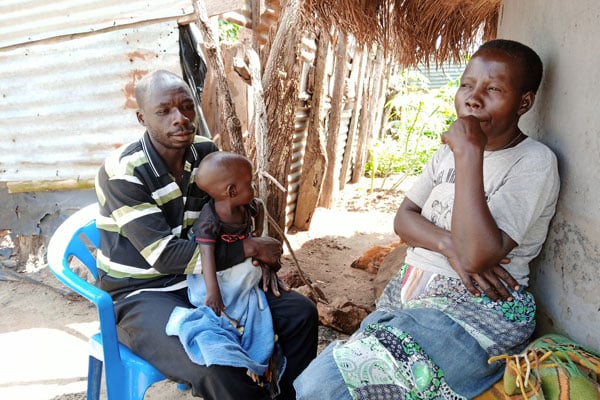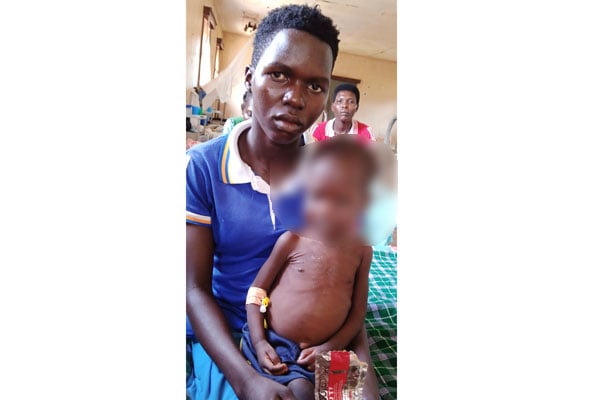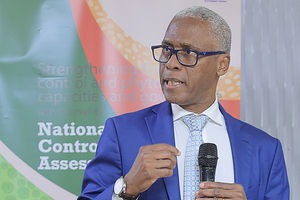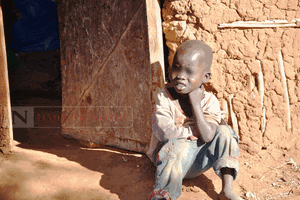
Christopher Ojok carries his one-year-old malnourished child in Opit Upper Cell, Omoro
Town Council, on September 25, 2024. PHOTO | BILL OKETCH
A woman bends down to smear the verandah of her grass-thatched hut with cow dung in Opit Upper Cell, Omoro Town Council in Omoro District. Her neighbour, Night Aloyo, sits on a piece of cloth spread on a dusty verandah. She is carrying a sickly-looking child, whose dirty brown hair is sparsely distributed on the head. He is one-year-old.
“He is sick most of the time. The disease started when he was 10-months-old. He has persistent diarrhoea and I estimate that on average, we spend Shs20,000 per week on his treatment,” she says.
Aloyo and her husband make a living through selling roasted maize in Omoro Town. Last month, their child was identified by a member of the area Village Health Team (VHT) as one of those suffering from acute malnutrition.
He was taken to the nearby Lacor Health Centre III-Opit, screened and found to be suffering from moderate acute malnutrition. Today, he is among hundreds of malnourished children in Omoro and Otuke districts that are linked to care, service and treatment.
“At the end of the month, the child is given one kilogramme of sugar, two bars of soap, and some non-food items. We have started planting maize in our two-acre garden. If the weather does not fail us, at least, we shall not feel the hunger pangs again,” Aloyo says.
According to the 2023 Joint Child Malnutrition Estimates by the United Nations Children’s Fund (UNICEF), World Health Organisation (WHO), and the World Bank, acute malnutrition is affecting more than 268,000 children in Uganda.
Over the years, though, the country has made progress in the fight against malnutrition, reducing stunting from 45 percent in 2001 to 24.4 percent in 2022, reducing underweight children from 16 percent in 2006 to 10 percent in 2022 and reducing wasting in children from five percent in 2001 to three percent in 2022. Unfortunately, the rate of reduction in malnutrition will not allow the country to achieve its global commitments.
Another mother, Betty Awor, cradles her four-year-old son. The child has failed to hit the development milestones for his age as a result of disease, poor health and malnutrition. With his dry and rough skin, covered with rashes, and his swollen lower limbs, the child looks as though he is two-years-old.
“I always buy painkillers for him. His condition has baffled me. We only eat one meal a day and sometimes we go to bed hungry because we are poor,” Awor says.

This child is among 14 children with severe acute malnutrition under care at Lira Regional Referral Hospital as of October 3. PHOTO/ BILL OKETCH
Ruth Robinah Akello, a clinical officer at Lacor Health Centre III-Opit, advises parents such as Awor to take their children to the nearest health facility to get proper diagnoses.
“Children suffering from severe acute malnutrition may have abnormal distention or swelling of the lower limbs. At times, malnutrition mimics other conditions such as sickle cell disease. Generally, if the child is not hitting the development milestones, visit a hospital,” she says.
While moderate acute malnutrition is managed at lower health units, severe acute malnutrition is managed either at health centre IVs or regional referral hospitals. Every three in 10 suspected cases taken to Lacor Health Centre III-Opit for screening turns out positive for acute malnutrition.
“Children who suffer from chronic illnesses such as sickle cell disease, Aids and tuberculosis are at risk of malnutrition. Therefore, their caretakers should be on high alert. They should be well informed about nutrition because those children need special food,” Akello says.
According to the Integrated Food Security Phase Classification Acute Malnutrition scale (IPC AMN), of the 10 districts analysed in northern Uganda from May 2019 to April 2020, acute malnutrition is at the Alert level (IPC Phase 2) in Omoro and Otuke districts and an Acceptable level (IPC Phase 1) in the other eight districts.
Contributing factors
More than one in every 20 children is affected by acute malnutrition in Otuke and Omoro districts. In Lira district, as of last week, at least 14 children are admitted in the nutrition unit of Lira Hospital with severe acute malnutrition, according to Peter Okello Odeke, the hospital administrator.
This Unit was built in 1928 and is now a condemned structure. However, we cannot break it down because we would have nowhere to put these children,” he says.
In Omoro district, Douglas Peter Okello, the LCV chairperson, names the worst affected sub-counties as Odek, Acet and Otapwoyo where 287 households have children infected with the nodding syndrome.
“Parents are having difficulty providing a nutritious diet to children affected by the nodding syndrome. The disease has also crippled the households’ ability to produce enough food because they have to constantly attend to their children instead of going to the gardens,” he says.
High acute malnutrition in northern Uganda is attributed to inadequate food consumption, disease, inadequate water, poor sanitation and low purchasing power in rural households. Most families in the region can hardly afford two meals a day.
In Otuke District, acute malnutrition is concentrated in Olilim, Ogor and Adwari sub-counties. Francis Abola, the LCVI chairperson of the district says these areas are prone to extreme weather events such as floods and drought.
“The district is located in a semi-arid region, which leads to low quality harvests and sometimes, crop failure. Secondly, energetic young people, who would have supported their families in food production, have abandoned the villages for urban centres where they engage in criminal activity,” he says.
The sandy soil in the district does not support intense crop production. The main food crops grown include sorghum, millet and oilseeds (sesame, groundnuts, sunflower and soybeans). The oilseeds are produced mainly for sale, not home consumption. Stakeholders now suggest that the residents should instead turn to livestock farming. Dr Patrick Opio, Otuke’s district health officer (DHO), says viral load suppression in HIV positive children and adolescents is low partly because of malnutrition.
“Where there is inadequate quantity and quality of food in the house, just expect that malnutrition will be there. An HIV positive person has to eat well to enable them to adhere to the treatment regime. The viral load suppression in children and adolescents ranges from 78 percent to 80 percent while that of adults stands at around 94 percent,” he says.
Challenges
Christopher Anderuku, the in-charge of Lacor Health Centre III- Opit, says the biggest challenge facing the unit is the short supply of ready-to-use therapeutic food (RUTF), which is supposed to be given to severely malnourished children.
RUTF is an energy-dense, mineral and vitamin-rich food that requires no preparation. RUTF has a similar nutrient composition to F-100 therapeutic milk, which is used to treat severe malnutrition in hospital settings.
“We are good at identifying sick children but when you need to dispense treatment using therapeutic food, it is out of stock. Sometimes, the supplies only come once. If the supply issue is strengthened, we will be able to manage our patients at facility level,” he says.
Of the 28 health facilities (11 health centre IIIs, 1 health centre IV and 15 health centre IIs) in Omoro District, none has ever received an adequate supply of RUTF.
“We are normally given small batches for a particular period of time. We are told to use that while the powers that be lobby for more. Whatever they bring does not last a month, and then, we have to wait for months before another supply is dispatched,” Anderuku adds.
He advises that the only way to address the inadequate supply of RUTF is to deliver consignments to health centres that correspond with the number of patients.
Sheila Nduhukire, the spokesperson for the National Medical Stores (NMS), told this newspaper that the delivery of RUTF was scheduled for the week of October 7.
“The delay in the delivery of vital commodities in the fight against malnutrition was caused by the total shutdown of Karuma Bridge for scheduled major repairs,” she says.
Peter Eceru, a programme manager with Action for Hunger Uganda, says the stock outs of RUTF are worsening the problem.
“Generally, government investment of public resources in Nutrition Commodities has been minimal. According to the NMS, in the 2023/24 Financial Year, Nutrition Commodities have a funding gap of 89.2 percent. This explains the persistent stock outs because funding for Nutrition Commodities has been left to development partners,” he says.
According to the NMS report, the procurement need for the 2023/2024 Financial Year was USD $68,614,615 (Shs252.4 b). However, the commitments available amounted to USD $7,392,244 (Shs27.1b).
According to the Nutrition Annual Performance Report FY 2022/23 of the Ministry of Health, most of the regions reported on average 36 days of stock out of RUTF. Kampala reported the highest stock out rate while Karamoja reported the lowest (nine days of stock out).
The report indicates that the stock outs can be attributed to interruptions in distribution due to the transition from the UNICEF system to the NMS schedules.
Despite these interruptions, emergency distribution was carried out in the Karamoja sub-region with support from UNICEF to address the high levels of severe acute malnutrition that was experienced in the region.
To fight the disease, the Omoro District local government approved a Nutrition Action Plan in the 2023/2024 Financial Year. The Action Plan entails feeding cultures and types of food that an expectant mother must have.
A committee, chaired by the assistant DHO in-charge of maternal and child health, undertakes the breastfeeding initiative audit to find out whether mothers are continuing to breastfeed their newborns as guided by health workers. Under this arrangement, it is mandatory for men to accompany their pregnant wives during antenatal visits.
Douglas Peter Okello, the LCIV chairperson, says that the purpose of this intervention is to ensure the husband’s support towards feeding the baby before and after it is born.
“We discovered that sexual gender-based violence can affect a mother’s capacity to produce milk. We are addressing this through promoting role model men and women who show that there are different ways to solve problems,” he says.

Mr Douglas Peter Okello, Omoro District LCV chairperson
Conflicts in the home lead to low food production and erode the hygiene and sanitation aspects. The district is also sensitising the community on adopting smart agriculture and post-harvest management.
Partners’ intervention
In September, the United States government, through Feed the Future Initiative, launched a five-year Global Food Security Strategy (GFSS) to reduce hunger, poverty and malnutrition in Uganda.
The GFSS, which provides a framework for U.S food security and nutrition programming in 42 districts, builds on past achievements and lessons learnt, and prioritises inclusive participation, value addition, climate adaptation, and job creation.
Under this ambitious intervention, the government of Uganda in collaboration with development partners, the private sector, and civil society, and Feed the Future Initiative aims to improve natural resource management, strengthen agricultural markets, increase the consumption of nutritious food, promote resilience of households and communities, and adoption of healthy sanitation and hygiene behaviours.
Situation elsewhere
In Kamwenge District, a recent food and nutrition assessment conducted indicated 41 percent chronic malnutrition. The district is the second worst malnutrition hit district in Uganda, after Kabarole.
In the Karamoja sub-region, the situation is also dire with approximately 112,270 children aged between six and 59 months and 8,980 pregnant or breastfeeding women facing acute malnutrition. Of that number, 21,719 are severe acute malnutrition cases and 90,551 are moderate acute malnutrition cases.
The total number of children in need of treatment has increased by 25.7 percent from 89,000 in 2023 to 112,270 in 2024. The most affected districts in the sub-region are Kotido, Kaabong, Nabilatuk, and Napak.
Eceru says malnutrition is in some cases a result of food insecurity, but in some cases, it is a result of ignorance about what constitutes a balanced diet.
“The malnutrition problem is not just about food. Certainly, Kamwenge District is not one of those areas with food insecurity. The Karamoja sub-region, on the other hand, faces challenges of malnutrition on account of crop failure. Unfortunately, sensitisation on balanced diets has been limited,” he says.
A community monitoring report from Kikuube District, under the Right to Programme, demonstrated that communities in the district had never had any form of nutrition sensitisation.
The Uganda Annual Country Report 2023 of UN’s World Food Programme (WPF) shows that despite its agricultural potential and significant exports, Uganda’s food insecurity levels remain classified as ‘serious’ by the 2023 Global Hunger Index.
Malnutrition is widespread across the country, with 25 percent of children under the age of five stunted and 31 percent undernourished, putting them at risk of not reaching their full mental and physical potential.
Besides crop failures and lack of knowledge about a balanced diet, there are other compounding factors that promote malnutrition, including the high teenage pregnancy rate, children born to teenage mothers are more likely to suffer malnutrition, and gender-based violence. All these compounding factors need to be collectively addressed.
Cost
According to the WFP, Uganda spends USD $718m (about Shs2.6b), about 5.6 percent of the country’s gross domestic product, on combating malnutrition annually. “We need to strategically invest in nutrition-related interventions that have the highest returns on investment, such as investment in the early days and years of a child’s life, strengthening our school feeding programme, and recruiting additional human resources to support service delivery,” Peter Eceru, a programme manager with Action for Hunger Uganda, says.
He adds that the Uganda Food and Nutrition Policy 2003 needs to be reviewed, while the Food and Nutrition Bill 2009 needs to be debated and passed.




